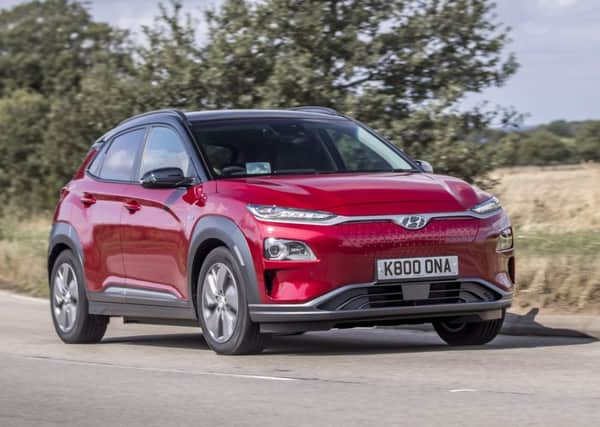Review: Hyundai Kona Electric


Welcome to the new world of electric cars – the future, they say. This week I experienced scenario two – a charging point which kept cutting out. The only alternative was a slow-charging plug on the same site which offered to give me 100 miles of boost if I waited more than four hours. I didn’t.
This month’s Geneva motor show was humming with electric contenders from most of the carmakers. Jaguar’s electric I-Pace was voted European Car of the Year. It is a gorgeous, quick, smooth and silent car but it still needs re-charging and it costs about £60,000.
Advertisement
Hide AdAdvertisement
Hide AdFor about half that you can buy an electric Hyundai Kona family hatchback, which probably has a greater range than the Jag (up to 300 miles) and with a 0-60mph time of seven point something seconds is super quick in everyday motoring. Foot down, whoosh.


Instead of a mesh face it has a blank body-coloured plastic panel: the charging sockets are behind a flap. There is one slow-charging socket and another which gives rapid charging – taking an hour for an 80 per cent charge. It is about as good as they get – its sister company Kia has just put the same power unit in its Niro and Soul cars. My problem could be your problem. I’d want my own charging point at home so that I didn’t have to stand in the icy rain trying to get the public charging point to work. Or find another car using it.
I’d paid £10 into a Genie Point charging account but this is not acceptable at rival sites so shopping around is limited to the chosen supplier. With a 100-mile journey to complete and a range of 150 miles now showing on the dashboard I was not inclined to divert to find another charging station which might or might not work.
Electric cars regenerate the battery recouped energy when slowing down. It’s a clever car. You don’t need the brakes much and you can adjust the level of braking energy.
The car’s navigation map will find charging points. To get an inside steer I rang a Hyundai dealership. The salesman was no help. The Hyundai website says the electric Kona is now out of stock for 2019.


Disclaimer: my experience may not be normal. Maybe I was unlucky. However, I see that testers from a car magazine had trouble finding working charge points. They were not alone. Things will improve. The number of charging points is increasing. They have to if electric motoring is going to be practical for most of us.
“The problem we have in this country is the charging network,” said Hyundai’s Robin Hayles. He wants commonality – my word – among the various systems, and better reliability.
Otherwise, the electric Kona is a blast. It’s a practical five-door shape with fold-down rear seats, though losing some luggage volume because of the battery pack under the floor. It has a smarter dashboard than a “normal” Kona, with a large information screen and all sorts of diagrams and switches and readings to keep you informed. Too many actually, with a distracting overlap of info. I imagine that all you need are one showing the range, the other showing the battery level, and, if you are on a road trip, where you can charge it up.
Advertisement
Hide AdAdvertisement
Hide AdRunning costs are reasonable. Because of the snags I had with charging I couldn’t do a cost analysis but the experts at nextgreencar.com reckon £3.70 per 100 miles.
The Kona had been delivered on a truck, with its battery level at 98 per cent, and showing a range of 260 miles. Aware that re-charging may be a problem, I conserved the battery. On the hopeless charging session I had used 24 precious miles and wasted 90 minutes. Yes, maybe I was unlucky. The call centre at Genie Point was helpful and knowledgeable and they did their best to resuscitate the charging machine.
The power from the electric motor is immediate, which makes the car as responsive as a Boggs GT Twin Turbo. There is not a second of lag. This car is eager. Remember wheelspin? The gears are direct. One button for drive, one for reverse, one for park, one for neutral.
Handling is not as sweet as a petrol or diesel Kona. The ride is harder. The silent engine is offset by tyre roar. The chassis feels a bit wooden and the car is substantially heavier. The lower powered 133bhp 39 kWh Kona E is 135kg heavier than a diesel Kona, while the higher powered, longer range 201bhp 64 kWh Kona E (as tested) is 285 kg heavier.
Verdict: This could be your sort of sensible car.